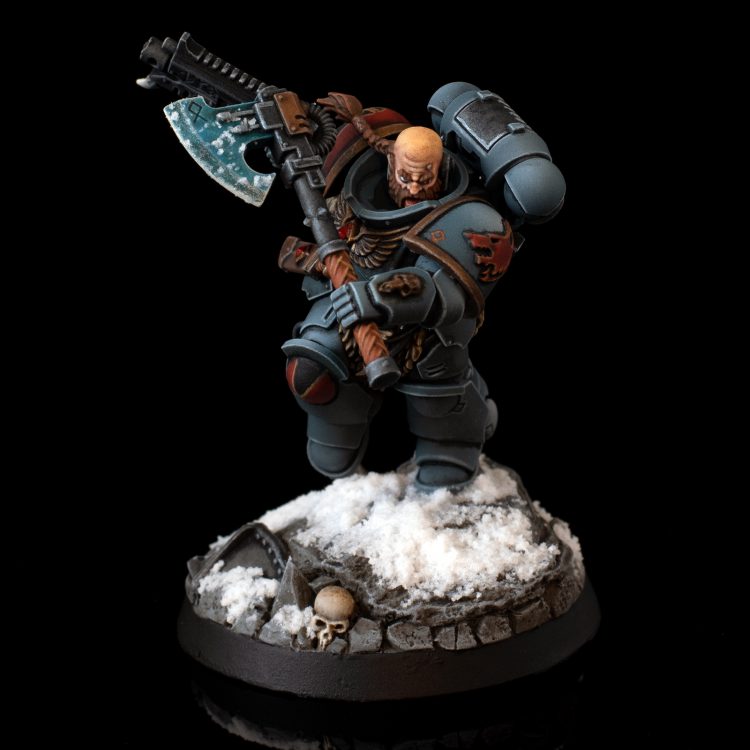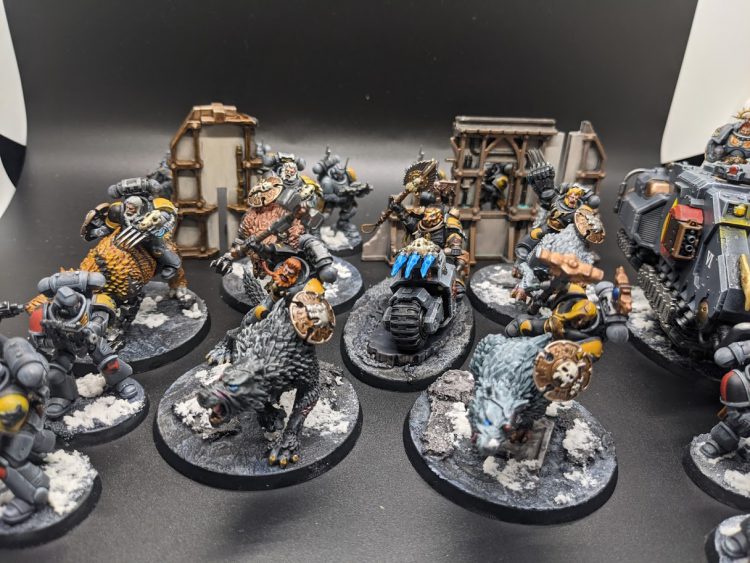White Dwarf 468 threw us a bit of a curveball this month, forgoing our usual campaign content in the Octarius sector for another Codex: Space Marines supplement, this time covering the Wolfspear Chapter, a Space Wolves successor chapter. The Wolfspear have their own chapter tactic, relics, warlord traits, and a trio of stratagems, bringing them on par with some of the other successor chapters in terms of the amount of rules they have access to.
But are these rules any good? How do they stack up, both in terms of competitive play and narrative play? Is it worth it to try and build a Wolfspear Chapter for your next Crusade army?
Chapter Tactic: Dark Terror
Wolfspear get +1 to Advance and charge rolls, and each time an attack is made from more than 18” away, treat this unit as having the benefits of light cover. This does what we’ve seen previous successor chapter rules do, combining Hungry for Battle and Stealthy from the Successor Chapter Tactics in Codex: Space Marines to create rules for a new chapter. As far as benefits go, these aren’t bad and tend to have at least a little synergy with each other, since you’ll want protection as you approach, but Space Wolves are already pretty fast and really just want to be as deadly in melee combat as possible. This isn’t really a strong enough combination, particularly when there are other better successor trait combos you could pick with Whirlwind of Rage.

Relics
Wolfspear get three relics of their own, plus they have access to the Special Issue Wargear in Codex Supplement: Space Wolves. Remember that you can take a single Space Wolves relic as well by spending 1 CP for the A Trophy Bestowed Stratagem. Which you’ll probably still do, in order to get the Armour of Russ.
- Elemental Shroud – this relic gives incoming attacks -1 to hit and makes you ineligible as a target for ranged attacks if you’re more than 18” away from the firing model, but you lose this benefit until your next Movement phase if you make any kind of move.
- The Totem of Storms gives you a once-per-battle-round re-roll on a psychic test or deny attempt.
- Blacktooth is a replacement for a knife or pair of knives and gives you +2 attacks plus all of your wounds turn into mortal wounds.
The knives here are pretty interesting, since they can turn a Phobos Captain into a real monster when it comes to shredding some larger targets. 8 attacks on the charge, maybe more depending on how you spec him out, and you can use Gene-Wrought Might or Savage Strike to improve his chances of wounding. The net result is a Captain who can lob out 5-6 mortal wounds on the charge pretty reliably, which is nothing to sneeze at. Unfortunately, this is the best trick in the Wolfspear arsenal. The Totem is OK but Space Wolves librarians are a dying breed these days as Grey Knights and Thousand Sons crowd the space and make being able to take Abhor the Witch more valuable.
Warlord Traits
Wolfspear trade out the Space Wolves’ Sagas for standard Warlord Traits, with no modes to turn into auras. Strike for the Throat gives your Warlord re-rolls to hit and an extra AP on melee attacks, while Hunt from Afar gives you automatic hits and wounds on rolls of a 2+ on ranged attacks against non-VEHICLE, non-MONSTER units. And Howling Beast gives you +2 attacks while within Engagement Range of any enemy models with Ld 7 or less.
These are, at best, OK. Howling Beast is an interesting prospect against Ork lists, but these are exactly the kind of Warlord Trait that 9th edition discourages – they lock you into situational bonuses that won’t be useful most of the time. Ld 7 or less units just aren’t very common, and when you do come across them they’re often targets you don’t want to be stuck in combat with. Strike for the Throat is probably the best of these, since it allows your Chapter Master to give someone else re-rolls to hit every turn and the extra AP can be very nice on a Thunder Hammer, where going from AP-2 to AP-3 is a good deal, but most of the time the Assault Doctrine is going to take care of that for you, and doesn’t stack with this bonus.

Stratagems
Finally we get three Stratagems for the Wolfspear chapter. These vaguely resemble some of the tricks we asw in Vigilus Defiant, though they’re similar in name more than ability. They all cost 1 CP.
- Track and Hunt is used at the end of the Movement Phase to pick an enemy unit within 24” of one of your Wolfspear Core units; that unit doesn’t get cover for the rest of the turn.
- Killing Blow is used in the Shooting or Fight phases to give a unit +1 to wound against a unit that’s either below Half Strength or consists of 1 model and has lost more than half its wounds.
- On the Scent is used in the Charge phase to pick an enemy unit that lost models or wounds this turn – you get to re-roll charges for Wolfspear Core units that charge them.
These are… well, they’re OK, I guess. Unlike the rest of these rules, they’re all upside in that you get them in addition to all the normal Space Wolves stratagems, so they’re just extra tools in your toolbelt. The downside is that they aren’t very good. Killing Blow is probably the most useful of these, since getting +1 to wound against a bigger model you’ve whittled down is pretty useful. On the Scent can also be useful but it’s only situationally better than just using a CP re-roll and requires jumping through extra hoops.
Final Thoughts
So where does this leave the Wolfspear Chapter? Are they a competitive dark horse? Well, no. White Dwarf have done a decent job of giving us a set of successor chapter rules that have an interesting hook or two, but, in the words of noted Space Wolves scholar JONK: “I’d never use these. The mortal wound Phobos captain is kinda funny but like it’s just not worth it.”
Leaving competitive by the wayside, that just leaves us with Crusade play and, if you’re into making a Wolfspear chapter army, these are fine. They’re not strong enough for competitive play, but fun tricks like the mortal wound Phobos captain will shine in an environment that quickly becomes dominated by unkillable characters, while the angle of making a more shooting- and stealth-focused wolves army is pretty neat and lends itself well to some less conventional builds, focusing more on Eliminators and Long Fangs and actually giving you a reason to consider Heavy Intercessors. Also the situational elements of things like the Warlord Trait matter less when you’ll tailor your list more to the opponent on a per-game basis later on in Crusade campaigns. If you’re interested in running something different with your Space Wolves and want to try a successor for your next Crusade, pick these rules up.
I’m of two minds when it comes to these rules: On the one hand, making them relatively weak does them a disservice by making it likely they’ll be left by the wayside and forgotten. On the other hand, it means that the issue isn’t a sure-fire “must buy” for everyone who needs the latest competitive edge for marines. I think ultimately making rules that are interesting, but not competitively pushed is the way to go and I’d love to see some non-marines rules tried out in a future issue.
Have any questions or feedback? Drop us a note in the comments below or email us at contact@goonhammer.com.


